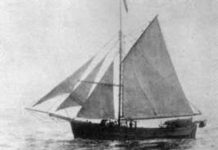Early on the morning of 5 August 1689, the fifteen hundred Iroquois warriors on the south shore of the St. Lawrence River launched their canoes. Under the cover of darkness and a violent thunderstorm, they paddled directly across the river and reached the shore at Lachine undetected by sentries at the three forts.
The Attack
Once ashore, the Iroquois dispersed into small groups among the snug, whitewashed houses and struck before dawn. The settlers were jolted awake by the screeching Iroquois war cry as naked, painted warriors burst into their homes. The initial assault was a wholesale slaughter; men, women and children were indiscriminately tomahawked. Once the Iroquois’ immediate bloodlust was sated, they began taking captives for torture back at their villages. Houses and barns were searched for victims, and then torched. Panic-stricken survivors ran for the stockades, where they would have been already but for Vaudreuil’s earlier decision to allow them back to their homes.
Three miles east of Lachine, a squad of two hundred French troops encamped by the road linking the village to Montreal was roused by the sound of cannon fire from one of the forts, signaling an Indian attack. The group’s commanding officer, Daniel d’Auger de Subercase, had gone to Montreal the previous evening to attend a reception for Governor Denonville and had not yet returned. Subercase’s second-in-command was ordering the soldiers to arm for battle when a survivor fleeing from the Iroquois stumbled into the camp. The subordinate officer ascertained the nature of the attack from the man, and then directed him to continue on to Montreal and raise the alarm. Inexplicably, the troops remained at their campsite.
An Aborted Pursuit
When Subercase learned of the attack, he immediately returned to his command. Several hours had passed since the carnage began, and Subercase was incredulous to discover that his troops had not gone to Lachine’s aid. By now, his men had been joined by soldiers from the forts and some settlers whose homesteads had been spared, and Subercase promptly led the combined force to Lachine. They were greeted by macabre sights of slaughter, including the bodies of several settlers who the Iroquois had taken time to torture.
Subercase was then informed that the Iroquois has found a large store of brandy in one building and drunk it down on the spot: most of the war party was now concealed in a grove of trees about one mile distant, sleeping off the aftereffects of their indulgence. The resourceful officer immediately saw an opportunity: though severely outnumbered, he believed that a sharp surprise attack – combined with the general grogginess of the enemy – would enable him to free the Iroquois’ captives and then complete a withdrawl to the nearby stockades.
However, before Subercase could act, Vaudreuil arrived with orders from Denonville: no unnecessary risks were to be taken, and all troops were to assume defensive positions to protect the colony from further attacks. Subercase, sickened and infuriated by the thought of abandoning the prisoners to die at the torture stake, argued vehemently with Vaudreuil, but in vain. Reluctantly, he ordered his men inside the stackades.
Aftermath
For the next two days, the Iroquois rampaged unchecked through the surrounding countryside, taking additional captives and destroying homesteads. Vaudreuil sent word to Denonville requesting additional troops. Eighty soldiers were dispatched from Montreal, but were ambushed by the Iroquois within sight of Lachine’s stockades. Vaudreuil refused to permit a sortie to aid them, and all but a handful were killed or taken prisoner.
Finally, the Iroquois took to their canoes with their prisoners and departed. In a final gesture of contempt, they paddled up and down the stretch of water before the three forts, shouting that they had repaid the treachery of “Onontio” (Denonville). Then they headed for the St. Lawrence’s south shore, where they made camp: that night, they celebrated by burning several prisoners at the stake. The following morning, they left for their homelands with their remaining captives.
The horror of the attack on Lachine led to exaggerated reports of loss and destruction. The actual number of settlers killed in the onslaught was twenty-four. Between seventy and ninety were taken prisoner: half of these unfortunates never returned. Of the seventy-seven houses in the area, fifty-six were destroyed. Ironically, the attack – intended as payback for Denonville’s failed assault on the Senecas in 1687 – was similarly unsuccessful in terms of inflicting significant and lasting damage. The Iroquois would wreck much greater havoc upon New France in subsequent offensives, but the ferocity of their onslaught at Lachine spread terror throughout the colony.
Sources:
- Costain, Thomas B. The White and the Gold: The French Regime in Canada. Doubleday & Company, Inc., Garden City, New York, 1954.
- Eccles, William J. Canada under Louis XIV. McClelland and Stewart Limited, Toronto, 1964.






